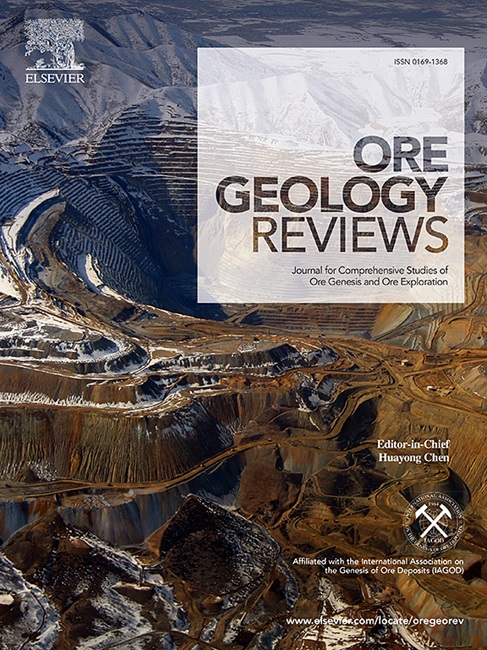海南岛西部土威山造山带金矿床元素迁移与热液蚀变
IF 3.2
2区 地球科学
Q1 GEOLOGY
引用次数: 0
摘要
图外山造山带金矿床位于海南岛西部,是三叠纪构造控制的金矿床。中元古代地质体中主要赋存花岗岩类,片岩和片麻岩也有少量赋存。这些矿床的成矿流体和物质的来源仍然是一个有争议的问题。基于土外山金矿床矿石和蚀变样地球化学新数据,采用质量平衡计算方法,研究了金矿成矿和热液蚀变过程中矿石和蚀变围岩元素迁移的趋势和幅度。结果显示,SiO2、K2O、Au、Ag、As、Bi、Pb、Cd、Cu、W、Sb、Zn、in、Tl、Cs、Rb、V、Zr、Hf和Eu显著富集,TFe2O3、FeO、Na2O、Mo、Sr、Sc、Co和Ni显著富集。相比之下,TiO2、Nb和Ga没有可测量的质量变化。此外,我们还记录了土外山金矿床中Mo与W、Au的地球化学分离。研究结果表明,导致硫化物矿物沉淀的铁元素完全来自于流体与围岩相互作用过程中的花岗质糜棱岩,黑云母向绿泥石的蚀变是矿床的主要蚀变过程。研究认为,华南板块与印度支那板块碰撞引发的奥陶系—志留系沉积岩变质作用,为葛震剪切带金矿床的形成提供了成矿流体、金及伴生金属。相分离和水岩相互作用是控制土外山金矿床金沉淀的主要机制。这些发现为前寒武纪地体显生宙造山带金矿床的形成提供了新的认识。本文章由计算机程序翻译,如有差异,请以英文原文为准。

Element migration and hydrothermal alteration of the Tuwaishan orogenic gold deposit in West Hainan Island, South China
The Tuwaishan orogenic gold deposit, located in the western part of Hainan Island, South China, is a structurally controlled gold deposit formed during the Triassic. It is one of several gold deposits hosted within Mesoproterozoic terranes, primarily granitoids with minor contributions from schists and gneisses. The source of ore-forming fluids and materials for these deposits remains a subject of debate. This study investigates the trends and magnitude of element migration in ores and altered wall rocks during gold mineralization and associated hydrothermal alteration, using mass balance calculations based on new geochemical data from ores and altered samples at the Tuwaishan gold deposit. Our results reveal significant enrichment in SiO2, K2O, Au, Ag, As, Bi, Pb, Cd, Cu, W, Sb, Zn, In, Tl, Cs, Rb, V, Zr, Hf, and Eu, alongside notable depletion in TFe2O3, FeO, Na2O, Mo, Sr, Sc, Co, and Ni. In contrast, no measurable mass change was observed for TiO2, Nb, and Ga. Additionally, we document the geochemical separation of Mo from W and Au within the Tuwaishan gold deposit. Our findings indicate that the iron contributing to sulfide mineral precipitation was entirely derived from granitic mylonites during fluid-wall rock interactions, with the alteration of biotite to chlorite representing the dominant alteration process in the deposit. We propose that metamorphism of Ordovician-Silurian sedimentary rocks at depth, triggered by the collision between the South China and Indochina blocks, provided the ore-forming fluids, gold, and associated metals responsible for the formation of the Gezhen shear zone gold deposits. Furthermore, we suggest that phase separation and water–rock interactions were the primary mechanisms controlling gold precipitation at the Tuwaishan deposit. These findings provide new insights into the formation of Phanerozoic orogenic gold deposits hosted in Precambrian terranes.
求助全文
通过发布文献求助,成功后即可免费获取论文全文。
去求助
来源期刊

Ore Geology Reviews
地学-地质学
CiteScore
6.50
自引率
27.30%
发文量
546
审稿时长
22.9 weeks
期刊介绍:
Ore Geology Reviews aims to familiarize all earth scientists with recent advances in a number of interconnected disciplines related to the study of, and search for, ore deposits. The reviews range from brief to longer contributions, but the journal preferentially publishes manuscripts that fill the niche between the commonly shorter journal articles and the comprehensive book coverages, and thus has a special appeal to many authors and readers.
 求助内容:
求助内容: 应助结果提醒方式:
应助结果提醒方式:


